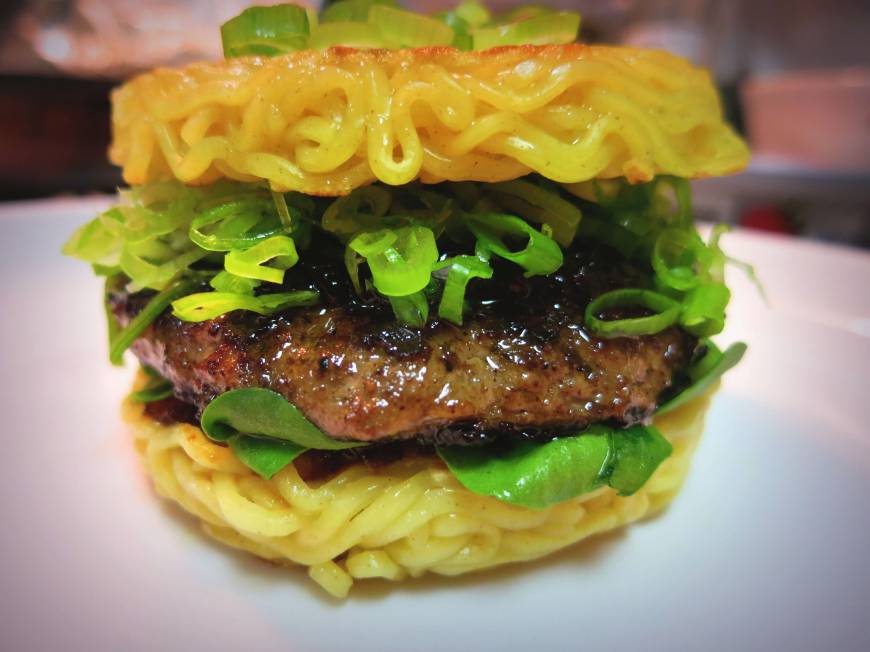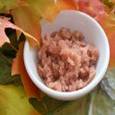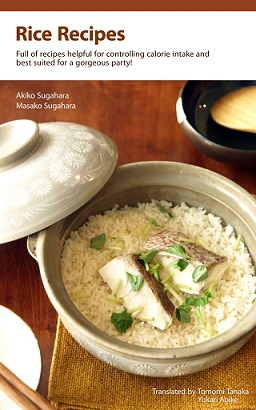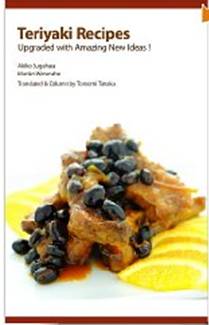Posted on Aug 22, 2013 on The Japan Times by Steve Trautlein
http://www.japantimes.co.jp/life/2013/08/22/food/the-ramen-burger-that-ate-new-york/

Who needs buns: Keizo Shimamoto and his ramen burger, which he serves to long lines of hungry diners in New York. | COURTESY OF KEIZO SHIMAMOTO
It’s too early to tell if Aug. 3, 2013, will go down as a landmark date in culinary history, but for the hundreds of people who lined up that morning at a food fair in Brooklyn, New York, the excitement was palpable. The crowds had braved steady rain for a chance to try the ramen burger, an East-meets-West concoction whose arrival was accompanied by breathless coverage in both old media and new. Although the buzz has yet to reach the level that greets a new opening from the likes of Danny Meyer or David Chang, the debut of the ramen burger was widely hailed as the foodie event of the summer.
All of this is as unlikely as it seems. Few cultures are as associated with a single food as America is with hamburgers, a dish that for more than a century has been much loved and little changed. The ramen burger offers a reinterpretation of the classic as Asian-inflected soul food, with noodles in place of the buns, a soy-based sauce instead of ketchup, and arugula and scallions standing in for lettuce, tomatoes and onions.
Keizo Shimamoto, the chef who dreamed up the dish, has a background as interesting as his creation. A 35-year-old second-generation Japanese-American, Shimamoto ditched a career in finance and moved to Japan to learn the craft of making ramen. I met him last year at popular Tokyo noodle shop Bassanova, where the California native had apprenticed as a cook and risen to the level of manager. We were there to discuss a tie-up between The Japan Times and Yahoo! Japan, which was running a promotion to drum up interest in noodles by enlisting foreigners as “Ramen Ambassadors.”
Shimamoto was a natural choice for the role of envoy. His blog, Go Ramen!, a daily chronicle of travels through noodle shops and ramen culture, had become an essential resource for the burgeoning international community of noodle fetishists. After his riches-to-rags story came to the attention of director Michael McAteer, Shimamoto found himself the subject of a documentary, “Ramen Dreams,” which took the prize for best short at the 2012 NYC Food Film Festival. The exposure opened up contacts in the industry and allowed him to perfect the ramen burger, a project that had occupied him for years.
“If I hadn’t gone to study ramen in Japan, I would never have been able to think about making the (dish),” Shimamoto told me last weekend from New York, where he had just finished his third stint at Smorgasburg, an al fresco assembly of food stalls in Brooklyn’s Williamsburg district. Although space for venders is limited and entry to the market highly competitive, Shimamoto has earned his place: The first weekend’s run of 150 burgers sold out in 20 minutes, and subsequent batches of 300 met a similarly ravenous response.
Interest in the ramen burger has been fueled by an overwhelming — and largely unintentional — media campaign. Perhaps the most galvanizing event for Shimamoto was an early August appearance on ABC’s popular TV show “Good Morning America,” during which he cooked ramen burgers in the studio for the program’s hosts and for other guests. In its wake came a flurry of coverage in prominent media outlets, among them Village Voice, CNBC, National Public Radio, Fox News, The New York Post, Eater and The Daily Beast. A profile of Shimamoto on BuzzFeed ran under the headline, “The Ramen Burger Could Save Us All.”
Shimamoto would be the first to admit that he didn’t invent the dish that’s making him famous: That distinction goes to Japanese chefs, and even fast-food chain Lotteria debuted a ramen burger in May. But his effort stands out in terms of substance and quality. He makes his patties with 75-percent lean USDA prime beef, and his noodles, sourced from a leading U.S. ramen maker, are fresh, not instant. The only thing he’s not forthcoming about is his method for congealing the ramen into bun-like consistency, which he describes as a “trade secret.” (A bevy of chefs on YouTube inspired by Shimamoto bind the noodles with egg.)
Shimamoto has seen enough of life to realize the importance of capitalizing on the momentum he’s developed. And the momentum is significant. “We’ve been getting offers every day from people who want to invest or manage events for us,” he told me. “The response and demand from people around the country and even around the world is amazing.” His plans for the near term involve continuing at Smorgasburg, but he’s also searching for a bricks-and-mortar location and wants to share his creation with food enthusiasts in other cities.
“I consider (my) ramen burger to be Japanese-American. Just like me. It’s not fusion food. It’s a food born in America that happens to combine two different cultures and makes them exist as one. The perfect symbol of America.”
_ _ _ _ _ _ _ _ _ _ _ _
Source: The Japan Times
http://www.japantimes.co.jp/life/2013/08/22/food/the-ramen-burger-that-ate-new-york/


 Autumn is the time when your summer tan fades and you need to make changes to your summer skincare regime. There is a crispness in the air and although the sun is not very harsh and strong you still need to use a sunscreen and moisturiser regularly. Follow a few guidelines and you could have problem-free skin all through the season.
Autumn is the time when your summer tan fades and you need to make changes to your summer skincare regime. There is a crispness in the air and although the sun is not very harsh and strong you still need to use a sunscreen and moisturiser regularly. Follow a few guidelines and you could have problem-free skin all through the season. Hot summer causes dehydration, and thereby wrinkles and fine lines appear on the skin. The moisture lost needs to be properly supplemented before the onset of winter. Moisturise at least twice daily after cleansing. Dry, normal and combination skin types may use a light oil free liquid or gel moisturiser. For drier skin types, choose a thicker cream based moituriser meant for dry skin. Along with your facial skin you need to take care of your body also. Be sure to take short warm baths and apply moisturiser onto your damp skin.
Hot summer causes dehydration, and thereby wrinkles and fine lines appear on the skin. The moisture lost needs to be properly supplemented before the onset of winter. Moisturise at least twice daily after cleansing. Dry, normal and combination skin types may use a light oil free liquid or gel moisturiser. For drier skin types, choose a thicker cream based moituriser meant for dry skin. Along with your facial skin you need to take care of your body also. Be sure to take short warm baths and apply moisturiser onto your damp skin. Intensive skin treatments come in the form of serums or concentrated emulsions and should be done on damaged skin once or twice in a year. Vitamin C, Vitamin E, Flavonoids and Retinoids (Synthetic Vitamin A) are good treatments to reverse sun damage and improve skin tone. Some moisturizers also come with Vitamins. For a better effect use both – apply serum under the moisturizer either twice daily or as a night repair treatment. You can also go for at home treatments using masks and packs. Skin lightening treatments are very popular during Fall. For using masks, you need to exfoliate your skin (Do not exfoliate more than twice a week), and prepare it for treatment.
Intensive skin treatments come in the form of serums or concentrated emulsions and should be done on damaged skin once or twice in a year. Vitamin C, Vitamin E, Flavonoids and Retinoids (Synthetic Vitamin A) are good treatments to reverse sun damage and improve skin tone. Some moisturizers also come with Vitamins. For a better effect use both – apply serum under the moisturizer either twice daily or as a night repair treatment. You can also go for at home treatments using masks and packs. Skin lightening treatments are very popular during Fall. For using masks, you need to exfoliate your skin (Do not exfoliate more than twice a week), and prepare it for treatment. Although the Autumn sun is not as strong as it was in summer, it is still necessary for you to use your sunscreen regularly. A sunscreen with SPF of atleast 15 is required in Autumn. Patch dryness, eczema and psoriasis, seborrhea and pityriasis rosea can start to flare. Even oily skin needs a moisturiser to keep oil production at bay, so use oil-free liquid moisturisers. If you have “sun spots” on your skin as a result of sun exposure last summer, you can go for exfoliation and whitening treatments. However, do consult your dermatologist before undergoing any treatment.
Although the Autumn sun is not as strong as it was in summer, it is still necessary for you to use your sunscreen regularly. A sunscreen with SPF of atleast 15 is required in Autumn. Patch dryness, eczema and psoriasis, seborrhea and pityriasis rosea can start to flare. Even oily skin needs a moisturiser to keep oil production at bay, so use oil-free liquid moisturisers. If you have “sun spots” on your skin as a result of sun exposure last summer, you can go for exfoliation and whitening treatments. However, do consult your dermatologist before undergoing any treatment. Summer means dehydration and therefore more water intake for replinishing the moisture lost, but that should not change once the temperatures drop. In fact, you should continue to drink at least eight glasses of water a day throughout the year, irrespective of sesonal changes. This will help you to flush out the body toxins better thereby ensuring a problem-free skin. Fall is a season when fresh fruit and vegetables abound, so you can include Pears, Leeks, Pumpkins, Sweetcorn, Broccoli, Cabbage, Carrots, Blackberries, Grapes, Plums and Raspberries to provide Vitamins C, B, E and A, Iron, Zinc, Calcium, Potassium, Bioflavonoids, Omega-3 Fatty acids etc.
Summer means dehydration and therefore more water intake for replinishing the moisture lost, but that should not change once the temperatures drop. In fact, you should continue to drink at least eight glasses of water a day throughout the year, irrespective of sesonal changes. This will help you to flush out the body toxins better thereby ensuring a problem-free skin. Fall is a season when fresh fruit and vegetables abound, so you can include Pears, Leeks, Pumpkins, Sweetcorn, Broccoli, Cabbage, Carrots, Blackberries, Grapes, Plums and Raspberries to provide Vitamins C, B, E and A, Iron, Zinc, Calcium, Potassium, Bioflavonoids, Omega-3 Fatty acids etc. Seattle, WA—Taking a 12-week yoga class and practicing at home was linked to less insomnia—but not to fewer or less bothersome hot flashes or night sweats. The link between yoga and better sleep was the only statistically significant finding in this MsFLASH (Menopause Strategies: Finding Lasting Answers for Symptoms and Health) Network randomized controlled trial.
Seattle, WA—Taking a 12-week yoga class and practicing at home was linked to less insomnia—but not to fewer or less bothersome hot flashes or night sweats. The link between yoga and better sleep was the only statistically significant finding in this MsFLASH (Menopause Strategies: Finding Lasting Answers for Symptoms and Health) Network randomized controlled trial. Dr. Akiko Sugahara Ph.D. has released her latest book in the series, “Akiko Sensei’s Healthy Recipes,” available now on the Amazon.com Kindle store. Co-authored by Masako Sugahara, the book offers more than 35 delicious, healthy recipes tested in the Sugahara Institute kitchens.
Dr. Akiko Sugahara Ph.D. has released her latest book in the series, “Akiko Sensei’s Healthy Recipes,” available now on the Amazon.com Kindle store. Co-authored by Masako Sugahara, the book offers more than 35 delicious, healthy recipes tested in the Sugahara Institute kitchens.


 Melatonin is a natural hormone segregated by the body and melatonin levels generally increase in the dark at night. It is also found in fruit and vegetables like mustard, Goji berries, almonds, sunflower seeds, cardamom, fennel, coriander and cherries.
Melatonin is a natural hormone segregated by the body and melatonin levels generally increase in the dark at night. It is also found in fruit and vegetables like mustard, Goji berries, almonds, sunflower seeds, cardamom, fennel, coriander and cherries.